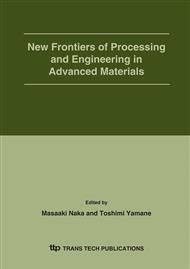p.437
p.443
p.449
p.455
p.461
p.467
p.473
p.481
p.487
Microstructure of SiC / TiAl Interface Formed by Solid-State Diffusion Bonding
Abstract:
The microstructure of the solid-state diffusion bonded interfaces of silicon carbide (SiC) and titanium aluminide (TiAl) were investigated. A 100-µm-thick Ti-48at%Al foil was inserted between two SiC specimens and then heat-treated in vacuum. The interfacial microstructure has been analyzed by scanning electron microscopy, electron probe microanalysis and X-ray diffractometry. Four layers of reaction products are formed at the interface by diffusion bonding: a layer of TiC adjacent to SiC followed by a diphase layer of TiC+Ti2AlC, a layer of Ti5Si3CX containing Ti2AlC particles and a layer of TiAl2. However, the TiAl2 layer is formed during cooling. The actual phase sequence at the bonding temperatures of 1573 K and 1673 K are described as SiC/TiC/(TiC+ Ti2AlC)/(Ti5Si3CX+Ti2AlC)/Ti1-XAl1+X/TiAl and SiC/TiC/(TiC+Ti2AlC)/(Ti5Si3CX+Ti2AlC)/Ti5Al11 /Ti1-XAl1+X/TiAl, respectively. The phase sequences are successfully expressed on the basis of the Ti-Al-Si-C quaternary chemical potential diagram.
Info:
Periodical:
Pages:
461-466
Citation:
Online since:
December 2005
Price:
Сopyright:
© 2005 Trans Tech Publications Ltd. All Rights Reserved
Share:
Citation:


